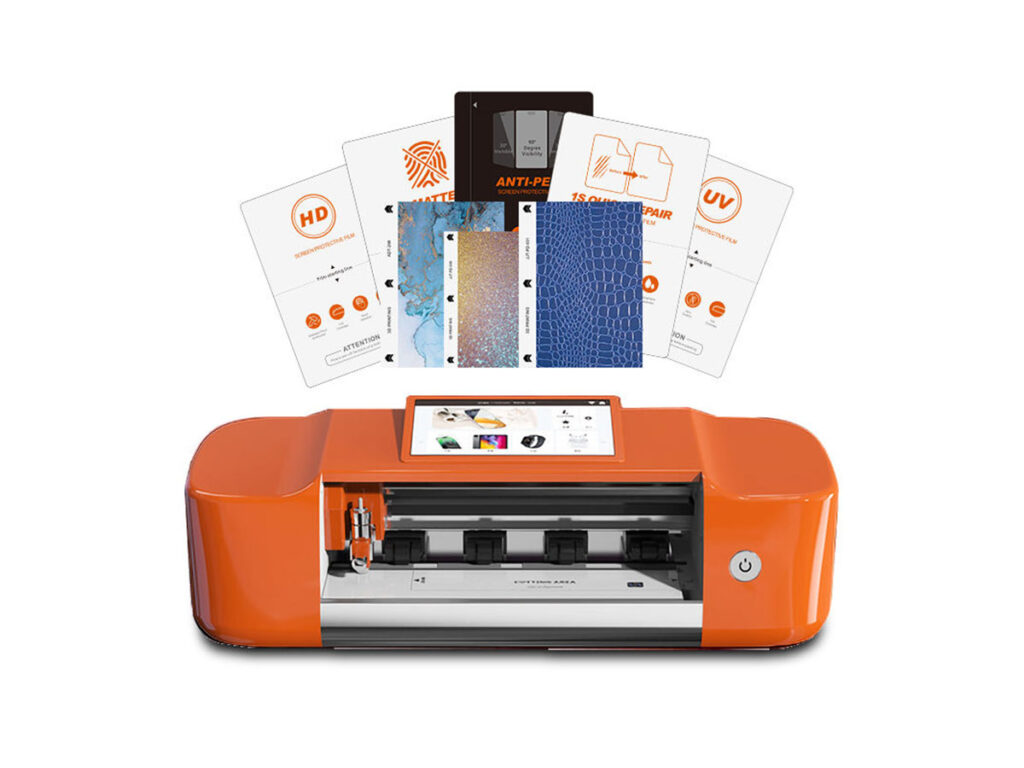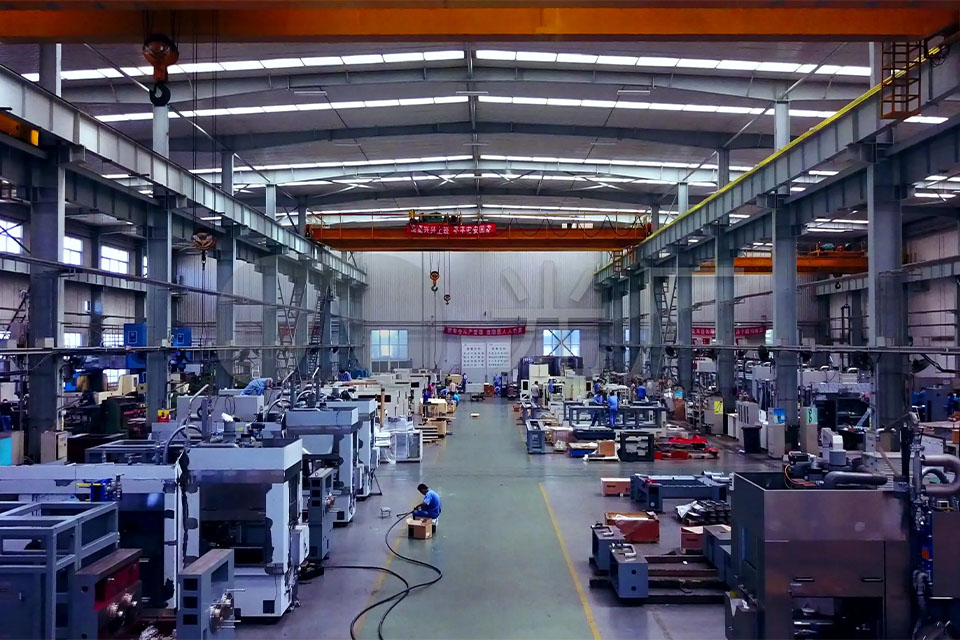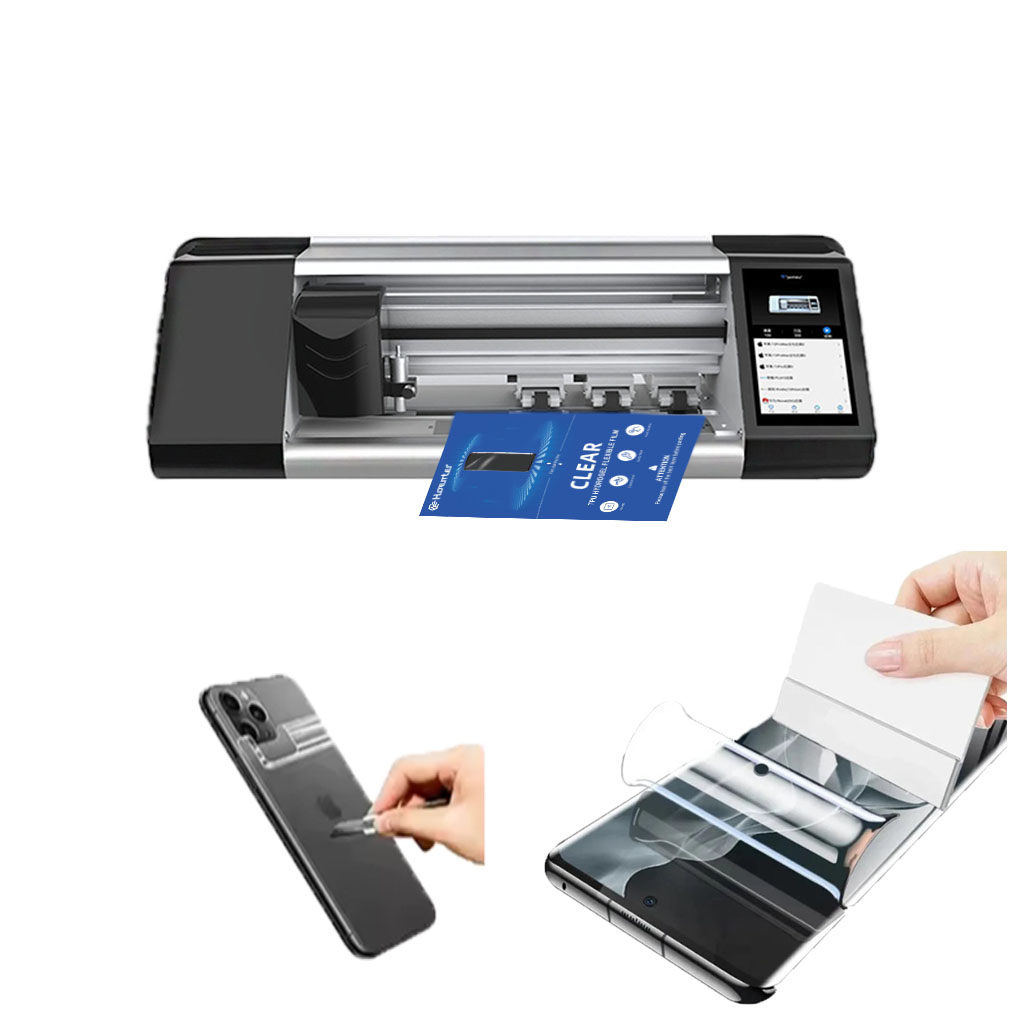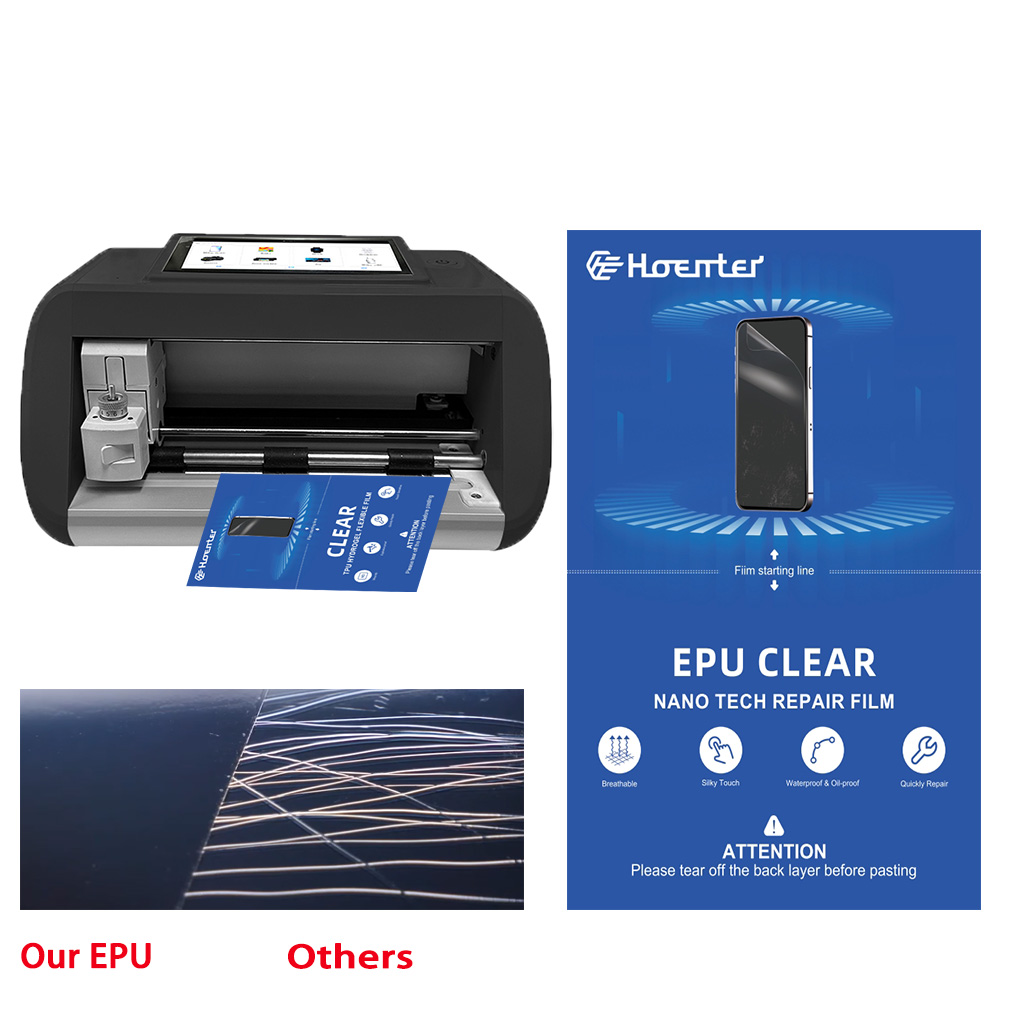
How a Screen Protector Cutting Machine Can Boost Your Business
Table of Contents
Summary
Originating in response to the need for protecting electronic device screens, these machines offer significant advantages over traditional manual cutting methods. By automating the process, they ensure consistency, reduce labor costs, and minimize material waste, making them invaluable assets for manufacturers and retailers in the mobile accessories market.
The evolution of screen protectors began in the late 1960s with the first patent by Herbert Schlegel, and has progressed from basic plastic films to advanced tempered glass and nano-coating technologies. These advancements have paralleled the increasing prevalence of touchscreen devices, heightening the demand for more durable and effective screen protection solutions. Modern screen protector cutting machines, utilizing precise cutting technologies like laser and physical cutting, cater to a wide range of materials, including tempered glass and thermoplastic polyurethane (TPU).
Screen protector cutting machines not only enhance production efficiency by significantly increasing output and reducing time, but they also offer substantial customization options. Businesses can create unique designs and incorporate personalized elements, such as logos and patterns, to cater to diverse consumer preferences. Advanced features like automatic material detection, safety sensors, and user-friendly software further augment the capabilities of these machines, ensuring high precision and user safety during operation.
The adoption of screen protector cutting machines can substantially boost business operations by streamlining SKU management, reducing inventory challenges, and providing scalable solutions through Over-the-Air (OTA) updates. As the market for mobile phone accessories continues to grow, driven by technological innovations and the increasing adoption of digital devices, screen protector cutting machines are poised to remain a cornerstone of the industry, offering significant benefits in terms of efficiency, customization, and cost-effectiveness.
History of Screen Protectors
The concept of screen protectors dates back to the late 1960s when Herbert Schlegel designed and patented the first screen protector in 1968, initially intended for use on television screens. The necessity for screen protectors emerged prominently with the advent of personal digital assistants (PDAs). These devices, which relied heavily on stylus input, often suffered from scratched LCD screens due to the stylus tips. To mitigate this damage, screen protectors were introduced, providing a sacrificial layer that absorbed scratches instead of the device’s screen.
Initially, screen protectors were primarily made from plastic and were designed to protect screens from scratches. However, these early plastic protectors were notorious for reducing screen clarity and were difficult to apply without trapping dust or air bubbles. Despite these shortcomings, they were a significant first step in the evolution of screen protection.
As technology advanced and touchscreen devices became more ubiquitous, the demand for more effective screen protectors grew. This led to the development of modern plastic screen protectors, which were clearer, more durable, and easier to install compared to their predecessors. The most significant advancement came with the introduction of tempered glass screen protectors. These not only offered superior protection against scratches but also provided better resistance to high-impact drops, greatly enhancing the protection of device screens.
The evolution of screen protectors continued with advancements in nanotechnology and the development of nano-coatings. These innovations brought about ultra-thin and transparent nano glass screen protectors that provided unparalleled strength and scratch resistance. Additionally, the screen protector industry has seen the incorporation of specialized filters such as privacy filters and blue light filters to meet the diverse needs of users.
Screen Protector Cutting Machines
Screen guard cutting machines have revolutionized the process of cutting and applying screen protectors. With their automated measurements, customization options, high-quality materials, and ease of application, these machines offer a convenient and efficient solution for protecting screens of various devices. Traditionally, cutting screen guards was a labor-intensive and time-consuming task, often resulting in inconsistencies and imperfections due to manual cutting methods. However, with the advent of screen guard cutting machines, these challenges have been effectively addressed through the use of precise cutting technologies, such as laser or waterjet, to achieve impeccable accuracy.
Benefits and Efficiency
By implementing screen guard cutting machines, manufacturers can significantly increase their production capacity. These machines can effortlessly cut multiple screen guards simultaneously, drastically reducing the time taken to complete the task. This increased speed and efficiency translate into higher productivity and greater profitability for businesses.
In terms of safety, screen guard cutting machines are designed with user protection measures in mind. They often have safety sensors that detect any obstructions between the laser and the material being cut, ensuring that the machine automatically stops if any interference is detected, thus preventing accidents or damage.
Customization and Flexibility
Screen guard cutting machines often come equipped with advanced features and ca- pabilities that further enhance their performance. For instance, some machines have automatic material detection, which ensures that the screen protector is properly aligned before cutting. This feature eliminates wastage and ensures accurate cuts. Additionally, many of these machines have built-in software that allows users to create and customize their own designs. This is particularly useful for businesses looking to offer unique screen protectors to their customers, as it allows for the addition of logos, patterns, or personalized messages.
Factors Influencing Precision
Several factors influence the precision of screen guard cutting machines:
Quality of cutting Blade: The quality and sharpness of the cutting blade play a vital role in determining the precision. A dull blade may result in uneven cuts that do not fit the device’s screen correctly.
Machine stability and Rigidity: The stability and rigidity of the cutting machine heavily influence its precision. Unwanted movements or vibrations during the cutting process can lead to inaccuracies and inconsistent cuts. Therefore, the machine must be constructed with sturdy materials to minimize vibrations and offer a stable platform for cutting.
Cutting Speed: The speed at which the machine operates can impact its precision. High speeds may reduce control and lead to inaccuracies, whereas slower speeds allow for better control and higher precision.
Software and Design: Advanced software with precise algorithms can ensure accurate measurements and consistent cuts. The design should be user-friendly, allowing operators to input custom measurements and easily adjust settings for different devices.
Material Compatibility: Different screen protectors are made from various materials such as tempered glass or plastic, each requiring specific settings and adjustments for precise cuts. A machine that offers a wide range of material compatibility and optimized cutting settings can enhance precision and efficiency.
Regular Maintenance and Calibration: Regular maintenance and calibration are crucial to maintaining precision over time. Cleaning the machine, replacing worn-out parts, and periodic calibration ensure optimal performance and extend the machine’s lifespan
Types of Screen Protector Cutting Machines
Screen protector cutting machines are divided into two main types based on their cutting mechanisms: laser cutting and physical cutting. Each type has its own set of advantages and disadvantages, catering to different needs in the market.
Laser Cutting Machines
Laser cutting machines are primarily used for cutting glass screen protectors. These machines employ laser technology to make precise and intricate cuts, ensuring a perfect fit for each device. The advanced software integrated into these machines allows for customization, enabling users to tailor the screen protectors to specific smartphone models or unique designs.
However, laser cutting machines come with certain drawbacks. They require a larger operating space and pose environmental pollution challenges due to the laser emissions. Despite these issues, their ability to cut high-hardness materials like glass makes them indispensable in certain contexts.
Physical Cutting Machines
Physical cutting machines, on the other hand, are used mainly for cutting flexible materials such as TPU (thermoplastic polyurethane). Unlike laser cutting machines, these do not require a large operating space and are more environmentally friendly. They are portable and suitable for mobile phone repair shops, providing a safer and cheaper alternative for cutting screen protectors.
The downside of physical cutting machines is that they cannot cut high-hardness materials such as glass. However, their ease of use and portability make them highly convenient for businesses focusing on flexible screen protectors.
Additional Technologies in Cutting Machines
Automated Measurements
Modern screen protector cutting machines often feature automated measurements. These machines come equipped with intelligent sensors that accurately measure the dimensions of the device, ensuring a perfect fit. This automation significantly reduces the time and effort required for manual measurements, enhancing efficiency and precision.
Customization Options
Customization is another crucial feature of these machines. They offer a range of options to cater to various devices, including smartphones, tablets, laptops, and custom-shaped screens. The ability to customize screen protectors helps businesses meet diverse consumer needs, thereby expanding their market reach.

High-Quality Materials
Screen protector cutting machines use premium materials like tempered glass and high-grade polymer films. These materials provide optimal protection for screens, being both scratch-resistant and maintaining excellent clarity. The use of high-quality materials ensures that the screen protectors not only safeguard the device but also retain its original visual quality.
Types of Screen Protector Cutting Machines
Screen protector cutting machines are divided into two main types based on their cutting mechanisms: laser cutting and physical cutting. Each type has its own set of advantages and disadvantages, catering to different needs in the market.
Laser Cutting Machines
Laser cutting machines are primarily used for cutting glass screen protectors. These machines employ laser technology to make precise and intricate cuts, ensuring a perfect fit for each device. The advanced software integrated into these machines allows for customization, enabling users to tailor the screen protectors to specific smartphone models or unique designs.
However, laser cutting machines come with certain drawbacks. They require a larger operating space and pose environmental pollution challenges due to the laser emissions. Despite these issues, their ability to cut high-hardness materials like glass makes them indispensable in certain contexts.
Physical Cutting Machines
Physical cutting machines, on the other hand, are used mainly for cutting flexible materials such as TPU (thermoplastic polyurethane). Unlike laser cutting machines, these do not require a large operating space and are more environmentally friendly. They are portable and suitable for mobile phone repair shops, providing a safer and cheaper alternative for cutting screen protectors.
The downside of physical cutting machines is that they cannot cut high-hardness materials such as glass. However, their ease of use and portability make them highly convenient for businesses focusing on flexible screen protectors.
Additional Technologies in Cutting Machines
Automated Measurements
Modern screen protector cutting machines often feature automated measurements. These machines come equipped with intelligent sensors that accurately measure the dimensions of the device, ensuring a perfect fit. This automation significantly reduces the time and effort required for manual measurements, enhancing efficiency and precision.
Customization Options
Customization is another crucial feature of these machines. They offer a range of options to cater to various devices, including smartphones, tablets, laptops, and custom-shaped screens. The ability to customize screen protectors helps businesses meet diverse consumer needs, thereby expanding their market reach.
High-Quality Materials
The landscape of screen protector cutting technology is continuously evolving, driven by advancements in materials science, precision engineering, and automation. These developments aim to further enhance the efficiency, customization, and environmen- tal sustainability of screen protector production.
How Screen Protector Cutting Machines Work
Screen protector cutting machines have revolutionized the process of creating and applying screen protectors by automating measurements and offering extensive customization options. These machines are designed to cut screen protectors with precision, using high-quality materials and advanced features, thus providing a convenient and efficient solution for safeguarding various device screens.
Types of Cutting Methods
Screen protector cutting machines can be broadly categorized into two types based on their cutting methods: laser cutting and physical cutting. Laser cutting is mainly utilized for cutting high-hardness materials such as glass screen protectors. However, it requires a larger operating space and can contribute to environmental pollution. On the other hand, physical cutting machines are ideal for cutting flexible materials like TPU (Thermoplastic Polyurethane). Although they cannot handle glass, they are environmentally friendly, portable, and suitable for mobile phone repair shops.
Advanced Features
Modern screen protector cutting machines come equipped with advanced features to enhance their functionality. One such feature is automatic material detection, which ensures that the screen protector is properly aligned before cutting, reducing wastage and guaranteeing accurate cuts. Additionally, built-in software allows users to create and customize designs, adding logos, patterns, or personalized messages to the screen protectors.
Cutting Precision and Accuracy
The precision of these machines is supported by fine numerical control technology, with current models capable of achieving a control accuracy of 0.1 mm. The cutting depth is adjustable, allowing the machine to handle different thicknesses of film materials and various hardness levels by controlling the knife pressure. High-precision film pressing wheels ensure that the film remains flat during the cutting process, further enhancing the accuracy of the cut.
Material Compatibility
Screen protector cutting machines are versatile in terms of the materials they can handle. They can cut various types of films, including PE (Polyethylene) film, PU (Polyurethane) film, PET (Polyethylene Terephthalate) film, and hydraulic films, which are used for explosion-proof screen protectors. This flexibility makes them suitable for a wide range of devices, from small screens like those on mobile phones and smartwatches to larger screens such as tablets and iPads.
Connectivity and Operation
These machines offer multiple connection methods, including mobile app, Bluetooth, or built-in operating systems, making them easy to operate and integrate into different workflows. With cloud databases, users can update the latest screen models at any time, ensuring that the machines are always equipped to handle new device releases.
Safety Features
In terms of safety, screen protector cutting machines are designed with user protection measures in mind. Many models feature safety sensors that detect any obstructions between the laser and the material being cut, automatically stopping the machine to prevent accidents or damage.

Benefits of Using a Screen Protector Cutting Ma- chine
Screen protector cutting machines have revolutionized the way screen guards are produced and applied, offering a plethora of benefits that enhance business opera- tions and improve user experience.
Efficiency and Productivity
In today’s fast-paced world, efficiency and productivity are paramount. Screen protector cutting machines streamline the cutting process, making it quicker and more efficient. This is particularly advantageous for businesses in the mobile phone accessories market, where demand for screen guards is high. By simplifying SKU management and eliminating excessive inventory and stock challenges, these machines help businesses save time and reduce costs.
Precision and Quality
The precision of screen protector cutting machines is unmatched due to the use of high-quality materials and sharp cutting blades. These machines ensure that each screen guard fits perfectly on the device, thereby prolonging the lifespan of the screen and enhancing the overall user experience. High-quality blades and regular maintenance are essential to maintain this precision. Additionally, some machines are equipped with automatic material detection, ensuring accurate cuts and minimizing wastage.
Customization and Innovation
Screen protector cutting machines offer extensive customization options. Businesses can use built-in software to create unique designs, add logos, patterns, or personal- ized messages, thus enhancing their branding and providing a wide range of options to consumers. Some machines even feature dual blades capable of cutting more complex designs, further pushing the boundaries of innovation in screen protector production.
Scalability and Integration
As businesses grow, the scalability of screen protector cutting machines becomes increasingly important. These machines integrate seamlessly into production lines, allowing companies to scale up production to meet rising demand. Their innovative capabilities also open new avenues for product development, enabling businesses to explore creative screen protector designs and features.
Safety and Environmental Considerations
Screen protector cutting machines are designed with user protection in mind. Safety sensors detect obstructions and automatically stop the machine to prevent accidents. Moreover, physical cutting machines are environmentally friendly and easy to carry, making them suitable for mobile phone repair shops. However, they cannot cut high-hardness materials like glass, which is where laser cutting machines excel.
Cost-Effectiveness
Investing in a screen protector cutting machine can be highly cost-effective. Businesses can expect substantial savings by reducing labor and maintenance costs through automated processes. The machines’ ability to handle various screen protector materials and designs also minimizes the need for excessive inventory, thus cutting down storage and logistical expenses.
Enhanced User Experience
Ultimately, the benefits of using a screen protector cutting machine translate into an enhanced user experience. Precision cuts ensure a perfect fit, while high-quality materials protect the screen effectively. The advanced features and customization options offered by these machines further elevate the quality of screen protectors, making them indispensable tools for any tech-savvy business.
Implementation in Business
Implementing a screen protector cutting machine can significantly enhance business operations in several ways. One notable improvement is in SKU management. By simplifying SKU management, businesses can eliminate excessive inventory and stock challenges, and resolve logistical issues. This eradicates the problem of unsold stock when phone models become obsolete, leading to substantial cost and time savings. Additionally, the system’s scalability is bolstered by Over-the-Air (OTA) updates, making it adaptable to future needs.
A practical example of such a machine’s effectiveness can be observed in the Triton Plus ULTIMATE Edition. This device allows for the creation of custom key profiles, enabling users to input specific space and depth information and link it to the keyway of their choice. It features a 12-Volt power adapter that can be powered by a vehicle cigarette lighter, which enhances its portability. Users benefit from unlimited, free updates via WiFi for the lifetime of the machine, ensuring that the system remains up-to-date with the latest technological advancements.
Moreover, the Triton Plus ULTIMATE Edition offers a fully integrated, all-in-one design with onboard storage for cutting bits and tracers, as well as a removable chip tray for easy clean-up. The machine is equipped with a bolt-down kit for secure mounting and comes with a 2 to 3-year warranty, depending on the model, which covers all machine failures due to manufacturing flaws. Free technical support is provided for the life of the machine, ensuring that any issues can be resolved promptly.
For businesses looking to integrate such a system, the process starts after payment is processed. While the company retains the right to suspend shipping if fraudulent activity is suspected, they commit to working with the carrier to resolve any delivery issues once the package has been shipped. It is important to note that the responsibility for the package transfers to the carrier once it has been dispatched.
Market Trends and Future Prospects
The market for mobile phone accessories, particularly screen protectors, is experiencing robust growth, driven by the increasing adoption of smartphones and other digital devices. This trend has intensified the demand for advanced screen protection solutions, pushing manufacturers to innovate continuously. Screen protector cutting machines, like those developed by Lensun, have become a cornerstone in this market, offering numerous advantages that cater to both manufacturers and consumers alike.
Technological Innovations
Technological advancements, particularly in materials science, have propelled the screen protector industry into a new era. Nanotechnology and graphene are at the forefront of this revolution, offering ultra-thin, transparent nano glass screen protectors with exceptional strength and scratch resistance. Additionally, Lensun’s screen protector cutting machines are equipped with dual blades capable of cutting protectors with complex designs, a feature currently exclusive to their machines.
Current Market Landscape
As of today, the market for screen protection is characterized by a significant shift towards high-efficiency production methods and customized solutions. The introduction of screen protector cutting machines has revolutionized operations within this industry by simplifying SKU management, eliminating excessive inventory, and resolving logistical challenges. These machines have allowed manufacturers to avoid the pitfalls of unsold stock due to the obsolescence of phone models, leading to substantial cost and time savings.
Benefits and Efficiency
The efficiency brought about by these cutting machines cannot be overstated. They enable manufacturers to produce customized screen protectors on demand, effectively addressing diverse consumer needs and preferences. Moreover, these machines support OTA (Over-The-Air) updates, ensuring that the technology remains current and scalable. This ability to adapt quickly to new phone models and market demands enhances the overall productivity and competitiveness of businesses in the screen protector market.
Future Prospects
Looking ahead, the screen protector market is poised for continued growth. With innovation at its core, companies like Lensun are well-positioned to lead this expansion. Their strong R&D capabilities and close cooperation with industry partners allow them to continuously upgrade their products and introduce new functionalities. As businesses strive to stay ahead of market trends, the adoption of cutting-edge technologies and efficient production methods will likely become even more prevalent.
Comments

Can You Put a Liquid Screen Protector on a Cracked Screen?
Applying a liquid screen protector on a cracked screen can be tempting, but it’s not a perfect solution.

Screen Guard Machine- The Essential Tool for Tech Lovers
Screen guard machines are specialized devices designed to produce protective films and shields for electronic screens, such as those on smartphones, tablets, and laptops.

How to Repair Mobile Phone Screen
By following this guide, you’ll be well-equipped to handle a cracked phone screen, saving both time and money.

UV Light Curing Machine for UV Sheet
The Universal UV Light Curing Machine for UV Sheet is crucial for businesses looking to deliver high-quality UV sheet applications, combining efficiency, durability, and user-friendly operation for outstanding results.

How Flexible Hydrogel Films Are Changing the Screen Protector Industry
Flexible hydrogel films are revolutionizing the screen protector industry by offering superior flexibility, durability, and self-healing properties, making them the future of screen protection technology.
Tags
Find All knowledge and trends from our blog, get the wholesale price and best quality from our factory.

What Film Cutting Machine and Its Application
Film cutting machines have played a crucial role in the evolution of filmmaking and various industrial processes by enabling precise cutting and splicing of film materials.

What Is a Screen Protector Cutting Machine?
A screen protector cutting machine is a specialized device designed to produce custom-fit screen protectors for various electronic devices, including smartphones, tablets, smartwatches, laptops, and monitors.

How Mobile Phone Screen Protector Cutting Machine Work?
A mobile phone screen protector cutting machine is a sophisticated device designed
to produce customized screen protectors for various digital devices with high preci
sion and efficiency.

Characteristics of Mobile Phone Tempered Glass and Mobile Phone TPU Screen Protector
Thermoplastic polyurethane (TPU) screen protectors are flexible, durable, and
self-healing plastic films designed to protect electronic device screens from
scratches, impacts, and other potential damages.

Revolutionize Device Protection with Screen Guard Cutting Machine
Whether you possess a smartphone, tablet, or smartwatch, this versatile machine accommodates a vast array of devices. It seamlessly adapts to the dimensions of your gadget, offering a custom fit that generic protectors can’t match.

Screen Protector Lifetime Warranty
A screen protector lifetime warranty is a guarantee provided by manufacturers that
promises to repair or replace a screen protector for the lifetime of the product, under specific terms and conditions.






